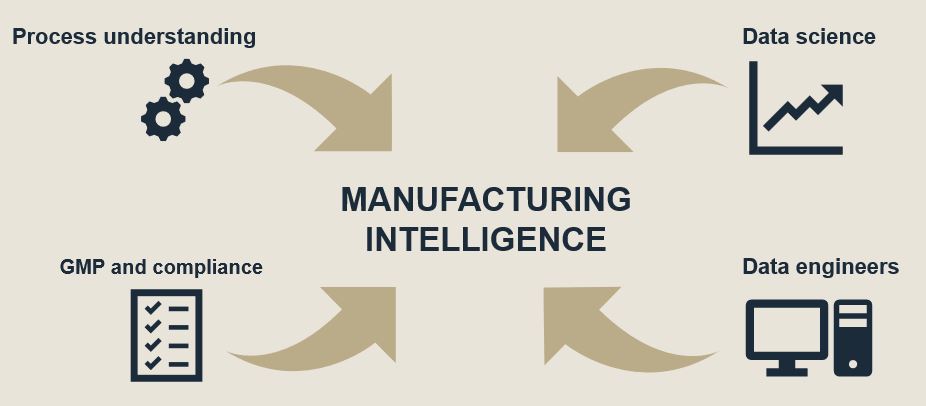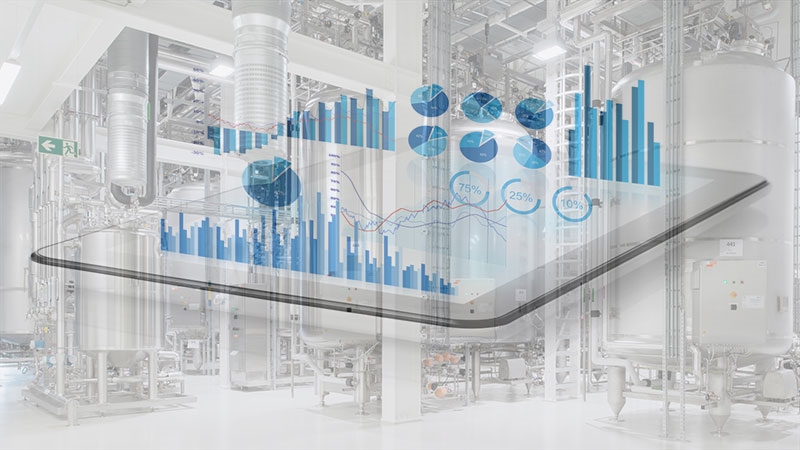The pharma industry continues to move towards manufacturing intelligence. But is this transition happening in the best possible way? In this TechTalk article, we offer some key advice on when to start analyzing data (spoiler alert – you should do it as soon as possible) and why process knowledge is so important, both to narrow down the data you collect, and to evaluate the quality of the models you create.
Manufacturing intelligence is the key to future success. But doing it in the right way is vital to make sure you get the most out of your investment. So, what is the optimal path to do manufacturing intelligence in pharma manufacturing? The key is to think big, start small, and scale fast.
Think big towards fully automated and adaptive manufacturing intelligence systems
Think big. That means considering what you really want and need in the future - and using that to form decisions now.
Long term, the goal is to move away from a manual system and into an automated one that automatically changes parameters based on running prediction models. This means having a system where all data is accessible in real-time, with adaptive models that are continuously optimized through artificial intelligence.
Overall, "think big" means:
- Making data-driven decisions in the long term
- Optimizing yield, speed and time through artificial intelligence and machine learning
- Empowering autonomous manufacturing
- Utilizing real-time release testing based on predictions from process measurements, not end product testing
Start small by analyzing your data early on
Thinking ahead to big things is important. But first, you must start small. This means analyzing the (often manually collected) data you already have.
A common mistake in manufacturing intelligence is focusing purely on IT e.g. enabling real-time data aggregation, making it accessible and then starting advanced analytics. This can now only take considerable effort and time, so business objectives may change, but it also focuses too much on a “magical AI data cloud” at the end of the tunnel.
The reality is, you do not create value until you start analyzing your data and start basing your decisions on the output of advanced analytics. In addition, remember to keep an agile mindset during these iterations. Eventually, you will get it right, and advanced analytics are key to demonstrating the worth of manufacturing intelligence.
You do not create value until you start analyzing your data and start basing your decisions on the output of advanced analytics."
So, how to start small and start analyzing early? First, consider the data you actually need and which data will help you better control your process. This includes brainstorming with process experts and prioritizing inputs.
The next step is closing the gap between what you need and what you already have by accessing data that may be missing or locked in silos.
Then, as you begin analyzing this data, you should in parallel start the IT journey of aggregating data and real-time access.
Finally, once you have analyzed the data and have some models and graphs, you can make more informed data decisions.
Overall, "start small" means:
- Harvesting benefits from rapid prototyping
- Giving input to the data enterprise architecture
Scale fast using a manufacturing intelligence platform
Once you have established your model prototypes and data architecture, you can set up your manufacturing intelligence platform and use this to scale fast.
The platform should function as a framework where future lines and equipment can be quickly added to predictive models and preventive actions. Put simply:
- Predictive models predict the future output of a line and allow you to make data-informed decisions that you perhaps hadn’t considered.
- Preventive actions adjust equipment based on model output and algorithms. This speeds up line and equipment changes, secures proper maintenance, and overall optimizes your manufacturing efficiency.
Ultimately, a well-configured manufacturing intelligence platform means moving away from small amounts of disconnected data and intuition and towards artificial intelligence that offers true predictive insight on real-time data. This can then be visualized on a dashboard or using augmented reality, giving you an overview of the entire manufacturing process and also more specific real-time insight into a line and what will happen if it continues in its current setup.
For example, you could check whether the current production line is on target, over target or under target. If the setup isn’t optimal, the manufacturing intelligence platform can suggest adjustments to improve these predicted outcomes.
Overall, "scale fast" means:
- Establishing a manufacturing intelligence platform
- Using this platform to accelerate the adding of new equipment and manufacturing lines based on the established data architecture
- Dashboards, predictive models and advanced visualization output
- Thinking about manufacturing intelligence services and reusability
GMP expertise, process understanding and a user-centric approach
There are four core competencies you need for manufacturing intelligence in pharma manufacturing:
- Process understanding
- GMP and compliance expertise
- Data science
- Data engineers

GMP expertise, for example, is very important when you consider adaptive modeling in real-time. If a model is controlling your process, it must be validated. But how do you validate a model that updates by itself?
It is an interesting challenge for pharma manufacturers, and an angle they need to be aware of when investing in manufacturing intelligence. Indeed, the FDA are already investing time into examining self-driven models that optimize automatically.
Process understanding is key to success in manufacturing intelligence
In addition, process understanding is vital. There is a misguided belief in the industry that once you have all your data, you can just run some models on it and get instantly smarter. But this doesn't work if you don’t have process understanding.
Why? Because process understanding ensures you look at the right data and can distinguish between correlation and causation.
Not all data is adding value. If data does not contribute any useful information, it is only adding noise. For example, a typical line with 5,000 data points updating by the second will collect a huge amount of data. But not all this data is necessary for analysis. Plus, there is a cost to adding a sensor that is GMP validated to each of these data points, so failing to narrow down your data can be expensive.
Not all data is adding value. If data does not contribute any useful information, it is only adding noise."
However, it is important to think broad when choosing which data to collect and analyze - as adding data later is also expensive. Ultimately, selecting the right data points with process experts and striking a balance is key.
And when you move on to analyzing data, where there may be four or five possible models to choose from, by far the most effective way to evaluate these models is by working with experienced process people.
A user-centric approach means valuable models
Finally, with all this in mind, it can be easy to forget the user – and creating an amazing model that nobody uses creates no value whatsoever. To drive change, optimize and empower your business, a good model is not enough. A user-centric approach is vital so the people closest to production can actually use the tool to ease their work and help them make faster and better decisions.
Have a vision, get the right people on board, and get started
To sum up, it is important to have a vision about where you want to go with manufacturing intelligence. You need to consider where you want to be in the future, and how much you want to automate. Then, start small by accessing the data manually, and begin your analysis early, so you can use these insights to make a plan for data architecture.
The long-term goal is to enable real-time data aggregation in the whole manufacturing space and to utilize your knowledge and data to employ adaptive modeling. And if all these developments go well, we may eventually have a “lights out factory” – not yet a reality in pharma manufacturing, but an exciting future that we are moving towards.


